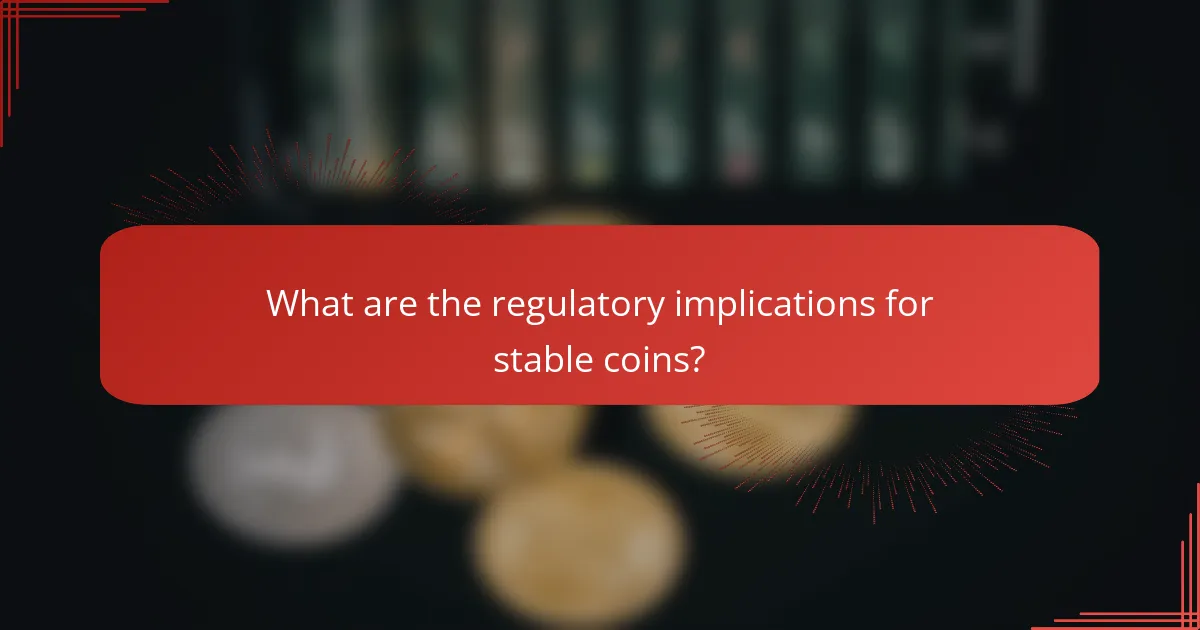Stable coins play a crucial role in the cryptocurrency market by offering a reliable medium of exchange that can facilitate quick trading actions. While their pegged values aim to reduce volatility, this stability can also be manipulated, raising concerns about market integrity. Additionally, the effectiveness of stable coins in maintaining their value is influenced by factors such as backing assets, regulatory scrutiny, and liquidity challenges.

How do stable coins affect market manipulation?
Stable coins can significantly influence market manipulation by providing a stable medium of exchange that traders use to enter and exit positions quickly. Their pegged value helps reduce volatility, but this stability can also be exploited for manipulative practices, impacting overall market dynamics.
Impact on price volatility
Stable coins tend to reduce price volatility in cryptocurrency markets by offering a reliable asset that traders can use during turbulent times. When traders convert their holdings into stable coins, it can create temporary price stability for other cryptocurrencies, as demand for stable coins rises. However, if large amounts of stable coins are suddenly sold, it can lead to sharp price declines in the underlying assets.
For example, during market downturns, many investors flock to stable coins to preserve value, which can stabilize prices in the short term. Conversely, if a significant amount of stable coins are liquidated, it could trigger panic selling and increased volatility.
Influence on trading volume
The presence of stable coins can enhance trading volume by facilitating quicker transactions and providing liquidity. Traders often use stable coins to capitalize on price discrepancies across exchanges, leading to increased trading activity. This can create a more dynamic market environment, but it also opens the door for potential manipulation through wash trading or other deceptive practices.
In markets where stable coins are prevalent, trading volumes can surge, especially during periods of high volatility. This can lead to misleading signals about the health of the market, as inflated volumes may not reflect genuine interest but rather manipulative trading strategies.
Case studies of market events
Several notable market events illustrate the impact of stable coins on manipulation. For instance, during the 2020 DeFi boom, the rapid adoption of stable coins like USDC and DAI enabled traders to exploit arbitrage opportunities, leading to significant price fluctuations across various platforms. This period saw both increased liquidity and instances of price manipulation as traders leveraged stable coins for quick gains.
Another example occurred in early 2021 when the sudden influx of Tether (USDT) into the market coincided with sharp price increases in Bitcoin and Ethereum. Analysts noted that this influx was often followed by rapid sell-offs, suggesting that the stable coin was used to manipulate prices temporarily before traders exited their positions.

What are the stability concerns of stable coins?
Stability concerns of stable coins primarily revolve around their backing assets, regulatory challenges, and liquidity issues. These factors can significantly impact their ability to maintain a stable value, which is essential for their intended use as a reliable medium of exchange.
Backing asset risks
The value of a stable coin is typically pegged to a backing asset, such as fiat currency or commodities. If the backing assets are not adequately secured or are subject to volatility, the stable coin may lose its value. For example, stable coins backed by cryptocurrencies can experience drastic price fluctuations, undermining their stability.
Investors should assess the quality and liquidity of the backing assets. A stable coin backed by a mix of high-quality assets may be more resilient than one relying on lower-quality or illiquid assets. Regular audits and transparency regarding the backing assets are crucial for maintaining trust.
Regulatory challenges
Stable coins face a complex regulatory landscape that varies by country. Governments are increasingly scrutinizing these digital currencies to ensure compliance with financial regulations and consumer protection laws. This scrutiny can lead to sudden changes in regulations that may affect the operation and acceptance of stable coins.
For instance, in the European Union, the Markets in Crypto-Assets (MiCA) regulation aims to create a comprehensive framework for crypto assets, including stable coins. Companies issuing stable coins must stay informed about evolving regulations to mitigate risks associated with compliance failures.
Liquidity issues
Liquidity is critical for stable coins to maintain their peg to the underlying asset. If a stable coin lacks sufficient liquidity, it may struggle to maintain its value during periods of high demand or market stress. This can lead to price deviations from the intended peg.
To enhance liquidity, stable coin issuers should ensure that there are enough trading pairs available on various exchanges. Additionally, establishing partnerships with liquidity providers can help stabilize the market during volatile conditions, reducing the risk of significant price swings.

How do different stable coins compare in stability?
Stable coins vary significantly in their stability based on their underlying mechanisms and collateralization methods. Tether (USDT) and USD Coin (USDC) are two of the most prominent examples, each with unique features that affect their reliability and market behavior.
Tether (USDT) vs. USD Coin (USDC)
Tether (USDT) is one of the oldest stable coins and is pegged to the US dollar. Its stability has been questioned due to concerns about its reserves and transparency, leading to occasional price fluctuations. In contrast, USD Coin (USDC) is backed by fully reserved assets and undergoes regular audits, which enhances its credibility and stability in the market.
When comparing the two, USDC tends to maintain a more consistent peg to the dollar, often trading very close to $1. This reliability makes it a preferred choice for users seeking stability in transactions and holdings. Tether, while widely used, has faced scrutiny that can lead to temporary instability.
TrueUSD (TUSD) vs. DAI
TrueUSD (TUSD) is a fully collateralized stable coin that is pegged to the US dollar and is regularly audited to ensure transparency and trustworthiness. This makes TUSD a reliable option for users looking for a stable asset with minimal risk of devaluation. Its stability is supported by a clear reserve structure, which is crucial for maintaining its dollar peg.
On the other hand, DAI is a decentralized stable coin that is backed by collateralized debt positions (CDPs) in various cryptocurrencies. While DAI offers flexibility and decentralization, its stability can be affected by the volatility of the underlying assets, leading to potential fluctuations in its value. Users should weigh the trade-offs between the reliability of TUSD and the innovative, but riskier, nature of DAI when choosing a stable coin for their needs.

What are the regulatory implications for stable coins?
The regulatory implications for stable coins are significant as they can affect market stability and investor protection. Authorities worldwide are increasingly scrutinizing these digital assets to ensure compliance with financial regulations and to mitigate risks associated with market manipulation and systemic instability.
Global regulatory landscape
The global regulatory landscape for stable coins varies widely, with some countries embracing them while others impose strict restrictions. Regions like the European Union are developing comprehensive frameworks, such as the Markets in Crypto-Assets (MiCA) regulation, which aims to provide clarity and safety for users and issuers alike.
In contrast, countries like China have outright banned stable coins, citing concerns over financial stability and capital flight. This divergence creates a complex environment for international stable coin operations, requiring issuers to navigate multiple regulatory regimes.
Impact of US regulations
In the United States, regulatory implications for stable coins are evolving, with agencies like the SEC and CFTC taking active roles in oversight. Recent discussions have focused on classifying stable coins as securities or commodities, which could significantly impact their issuance and trading.
Potential regulations may include requirements for transparency, reserve backing, and consumer protections. For example, stable coin issuers might need to disclose their reserve assets and undergo regular audits to ensure they maintain sufficient collateral, which could enhance trust but also increase operational costs.

What are the best practices for using stable coins?
To effectively use stable coins, it’s crucial to understand their underlying mechanisms and the associated risks. Best practices include thorough research, risk management, and careful selection of the stable coin that aligns with your financial goals.
Risk management strategies
Implementing risk management strategies is essential when dealing with stable coins. Start by diversifying your holdings across multiple stable coins to mitigate the impact of any single asset’s volatility. Additionally, consider setting clear investment limits and using stop-loss orders to protect your capital.
Regularly monitor market conditions and be aware of regulatory changes that could affect stable coin stability. Establishing a routine for reviewing your investments can help you react promptly to market fluctuations.
Choosing the right stable coin
Selecting the right stable coin involves evaluating its backing mechanism, liquidity, and reputation. Stable coins can be fiat-backed, crypto-backed, or algorithmically stabilized, each with its own risk profile. For example, fiat-backed stable coins like USDC or Tether (USDT) are generally considered more stable due to their direct ties to traditional currencies.
Consider the liquidity of the stable coin in your trading environment. A stable coin with high trading volume will allow for easier entry and exit points. Research the issuer’s transparency and regulatory compliance to ensure that your chosen stable coin adheres to industry standards.

What emerging trends are shaping the future of stable coins?
Emerging trends in stable coins include increased integration with decentralized finance (DeFi) platforms, regulatory developments, and the rise of algorithmic stable coins. These trends are influencing how stable coins maintain their value and interact within the broader financial ecosystem.
Integration with DeFi platforms
Stable coins are increasingly being integrated into DeFi platforms, which allow users to lend, borrow, and trade without traditional intermediaries. This integration enhances liquidity and provides users with opportunities to earn yields on their holdings, often exceeding traditional savings rates.
For instance, platforms like Aave and Compound enable users to deposit stable coins and earn interest, while also allowing for collateralized loans. This creates a symbiotic relationship where stable coins facilitate transactions and provide stability in the often volatile DeFi landscape.
However, users should be cautious of smart contract risks and the potential for market manipulation. It’s advisable to conduct thorough research on the platforms and understand the underlying mechanisms of the stable coins being used.


